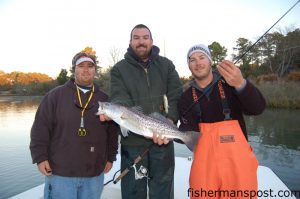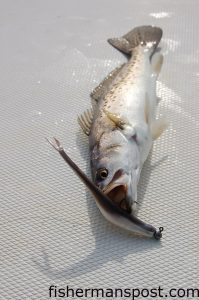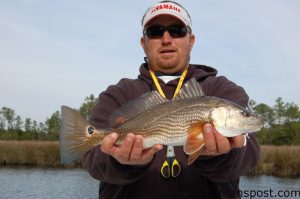Shiverin’ Specks

Capt. Robbie Hall, of Hall'em In Charters, Max Gaspeny, and Capt. Rob Koraly, of Sandbar Safari Charters, with a 5.1 lb. speckled trout that fell for a large mud minnow beneath a rattling float in a mainland creek off Bogue Sound.
“Frost on the boat,” Capt. Rob Koraly noted as he stowed some gear I’d just passed over the gunwale in the console of his 22’ Bay Rider. “I’m not used to that yet this year.”
The boat wasn’t the only thing frosty, as I was feeling the chill despite having donned a parka, one that often sees Wilmington winters come and go without ever leaving the closet, atop a half-dozen other layers I’d hoped would keep me warm.
The icy air figured into Koraly’s game plan, however, as he explained after we met up with fellow Swansboro Capt. Robbie Hall to begin a pre-dawn speckled trout hunt.
“The cold weather really stacks the trout up in our mainland creeks,” Koraly said, motoring slowly away from the dock behind his house and into one of the creeks. “The fish move out of the sound looking for someplace a little bit warmer, which pushes them either into the surf or these creeks. This creek’s got a silty bottom that keeps it a little warmer, so it’s one of the places where critters all come to get out of the cold.”
Koraly, who operates Sandbar Safari Fishing Charters, and Hall, of Hall’em In Charters, had teamed up to take Gary Hurley and I on an early December trout quest, and they were taking a novel approach given the big numbers of small “spike” speckled trout in the area this fall—they planned to fish a spot for a while, trailer the boat to another, and so on, taking us writers on a speckled trout tour of the Crystal Coast.
While there’d been big talk of the trout bite up-and-down the coast, nearly everyone was talking smaller fish, and one of our main goals was to catch them a variety of different ways in a host of disparate spots.
In Koraly’s eyes, though, our first spot had potential for more than just spikes.
“This spot is wintertime trout heaven,” he explained, turning a corner as we neared the back end of the creek. “There’s a hole here at the back that’s the deepest water until you get to the ICW. I’ve fished it three times this year. Each time I’ve gotten a big fish really early in the morning, and then it’s been all spikes.”
As Koraly shut the engine off, Hall moved to the bow and dropped the trolling motor into the dark water of the creek.
“I’ll keep us here with the trolling motor,” Hall offered. “You guys fish. There’s not a lot of current and we’re out of the wind, so I don’t think we need to mess with the anchor.”
Koraly set Gary and me each up with a light spinning outfit bearing a rattle-float rig and dipped a netful of mud minnows out of the Bayrider’s livewell.
“You guys want to cast to the corner of that bulkhead there,” the captain said, gesturing to a 90 degree turn in the seawall keeping the creek from climbing into a residential backyard. “They’ll sit right near that swim ladder a lot of the time.”
Several casts proved unproductive for Gary and me, but Hall snuck another float-rigged minnow towards a dock behind us and was quickly rewarded with a bent rod.
“Hey, that might not be a spike,” Koraly said, eyeing the bend in Hall’s rod while reaching for a landing net.
Moments later, Koraly was proven right, but the fish his fellow captain swung over the gunwale wasn’t a trout at all, but a puppy drum in the 15” range that had put up a decent account of itself on the light tackle.
“Sometimes you’ll catch absolute tons of those guys in the same places as the specks,” Koraly explained as the pup swam off.
A couple more unproductive casts later, the captains decided to move a little further upstream. A few moments later they had us casting to a point where the creek forked.
“Throw just off the grass and in front of that tree,” he instructed, motioning towards a live oak that hung low over the water.
My float was the next to sink, and I was soon reeling in the boat’s first spike of the morning. We admired the fish’s speckled, purple-silver flanks before sending it on its way.
Thus the bite began, and Gary, Robbie, and I were soon catching spikes with some regularity. Koraly added a few on a small smelt-colored Gulp bait he was casting on a light jighead.
“That’s the wintertime special,” he explained, pulling the Gulp out of another spike’s mouth. “That small bait in the smelt color is hard to beat when it’s cold.”
Despite his confidence in the little Gulp, both Hall and Koraly agreed that it’s hard to beat live baits when looking for the larger specks.
“Do you catch many big ones on artificials?” Hall queried. “I think those big fish are just a little too smart.”
“Yeah, a few,” the other captain responded, “but they’ve been few and far between. Live shrimp and mud minnows have caught a whole lot more.”
I’d just caught a pair of spikes on some small pinfish that were also making the rounds of Koraly’s livewell but decided to switch over to a minnow when I dipped up one of the largest I’d ever seen as I was going for my next bait.
As I held up the meaty minnow, Koraly noticed something about the rig.
“Slide that split shot up some,” he said, “You want it at least 18” from the hook so the bait can swim around a little better.”
Briefly after my second cast with the fat minnow had plopped down, the float disappeared and I lifted my rod against something rather more substantial than the 12-13” trout we’d been catching and releasing.
A surge against the reel’s drag caught Koraly’s attention, too.
“That ain’t a spike,” he said, hopping from behind the console to grab an extendable landing net and ready it for action.
I had to agree, given the fact that the fish was again making the drag sing and producing some sizeable boils in the glassy water beneath the overhanging oak.
With only one speck flirting with the state’s 5 lb. citation mark to my credit, I’m by no means an expert in the fight of a big trout. This fish’s violent headshaking, however, was flexing the rod well below the first guide, and I was beginning to believe my adversary was a fat trout instead of the drum its power first suggested.
The battle was soon headed my way, or so I thought as the fish’s surges grew less and less powerful, but it apparently had reserved a little energy for the endgame. The first time the float popped out of the water at boatside, Koraly was ready with the net, but the fish tore a few more feet of line off the reel, putting another deep bend in the light spinner.
“That’s a nice fish,” Koraly exclaimed, his tone a bit more elevated. “Nice trout!”
All I’d gotten a glimpse of was the float, so I still hadn’t put eyes to this prize, but I was inclined to trust the captain and the well-bent rod.
Angling forward, the fish seemed to be gravitating toward the trolling motor dangling from the opposite corner of the bow, but Koraly leapt to the bow platform, net in hand, to cut it off.

This spike trout that couldn't resist a smelt-colored Berkeley Gulp jerk shad on a light jighead at a narrow creekbend off the Neuse River.
As I worked the float again out of the water, Koraly was crouched on the bow and ready to put the trout in the boat.
“Lift him up when you get him close this time,” he coached.
I did so, willing the fish to stay hooked, and this time the net plunged into the water and emerged with a fish that looked like it could easily have eaten our spikes thrashing in the mesh bag.
“That’s a 5-pounder,” Koraly said, grinning as he pulled the fish from the net.
“If not, he’s really close,” Hall added, moving to the bow for a closer look.
Certified scales confirmed their estimates the following day, as the trout weighed 5.1, the largest I’ve landed to date.
I was ecstatic with the big speck and, after a brief photo session with the early morning sunlight filtering through the pines behind us, laid it to rest in a cooler beneath the Bayrider’s leaning post.
We continued fishing and catching spikes every few casts for the next half-hour, bumping around the area on the trolling motor, but saw no more big fish, prompting the captains to pull the plug on the spot.
“You guys want to go get some coffee?” Koraly asked. “We got our big one early here. Let’s head up the road and go catch some more.”
The big trout had erased the morning chill from my mind, but the prospect of a hot cup of coffee reminded me that the temperature was still below 40 degrees, particularly once we got out of the lee of the back of the creek.
“That’s really a great wintertime spot,” Koraly said, cranking up the motor. “There’s always some fish there, often some big ones, and when that north wind is honking in the wintertime, the backs of these mainland creeks are one of the nicest places to hide.”
After a quick coffee stop and a short ride east on Highway 24, we were stepping aboard the Bayrider again at a ramp between Swansboro and Morehead City.
“We call this truck fishing,” Koraly said with a grin as he headed back out into the ICW for a quick run to another mainland creek winding away from Bogue Sound.
Coming off plane after the brief but brisk ride, Gary and I again pinned mud minnows to the hooks on our float rigs as Koraly eased us into position with the trolling motor.
“You guys try casting at the pilings off the ends of those docks behind,” he said, pointing with his Gulp-rigged spinner.
“We’ve caught them pretty much all through here, though,” Hall assured as he casted a float to a mediocre looking area away from the structure.
My first cast resulted in another miniature bluefish, but Koraly was already unhooking another little trout by the time I’d released it.
As we worked through the area, casting to docks and pockets between them, Gary and I picked up a few fish on the minnows, but the Gulp baits that Koraly, and now Hall, were casting seemed to be doing more damage.
I created an ideal opportunity to switch over when I sent not one, but two looping casts over dock cleats, finally breaking the float off.
“Here,” Koraly said, handing me a rod rigged with a light jighead and a package of Gulps. “Give the Gulps a shot, and we’ll ease over and grab that float on the way out of here.”
I pinned one of the scented baits to the jighead, and moments after my first cast, the rod was vibrating with the headshakes of another little speck.
This was enough impetus to get Gary on the Gulp program as well, and he added a few more spikes to a total I’d already lost count of well before midday.
Our second creek continued to produce fish, but none like the early morning gator, and Hall and Koraly agreed that it was time to continue the “truck-fishing” and head for yet another spot.

Capt. Robbie Hall, of Hall'em In Charters, with a winter red caught on a Gulp bait in a creek off of the Neuse River.
“We caught fish here a couple days ago,” Hall explained as we crossed a bridge over a tiny creek a dozen miles outside Beaufort. “We’ll probably be coming back down here.”
Indeed, the captains decided to forgo another spot, and, a half-hour later, we were looking at the same bridge from the water.
Again, Koraly rigged some rattle-floats up for us, but instead of live bait hooks, these had Billy Bay Halo shrimp hanging 2’ beneath the corks.
“Cast over towards that pocket,” he said, rigging up another rod while he guided the boat with his trolling motor’s remote control.
Hall was again first to strike, swinging aboard a near-twin to his early morning puppy drum.
“Look how much more color they get in this water off the river,” he said, showing us the dark-copper flanks of a river red.
A handful of spikes came next as we maneuvered towards the bridge.
The action improved as we moved up the narrowing creek, keeping Hall busy with double hookups while he fished another live bait on a float rig and a Gulp bait. When Gary hooked a trout while Hall was battling another spike and a pup simultaneously, Koraly looked my way.
“You’re probably good to break out that fly rod now,” he said, setting the hook on his own spike. “I imagine you could hook one.”
Koraly had mentioned that we ought to bring a fly rod on the trip, since the spikes had been hitting just about every bait and lure imaginable, and I hurriedly got its four pieces together, the reel mounted, and the leader through the guides, finally tying the small pink Clouser minnow he suggested on the tippet.
The first sloppy cast I managed to send off the bow was almost immediately greeted by an enthusiastic little trout, even as I was thinking about trying to pick the fly up for a better shot.
“Well, there he is, that didn’t take long,” I said laughing, as I swung what may have been the day’s smallest fish over the gunwale (and a fish truly has to be small in order to pick it up with a fly rod).
A final stop near a creekmouth a few minutes later produced the best spike bite we’d seen all day.
Fish fell for flies, mud minnows, Gulp baits, Billy Bay and Storm soft plastic shrimp, and several other lures for the next 20 minutes, with at least two of us hooked up nearly the entire time.
A familial deadline necessitated Gary’s presence at home by 6:00 that evening, and a quick time check revealed we’d have to leave the fish biting. So after each of us caught a final spike, we called it a day and headed for the ramp.
I’m certain I caught more speckled trout over the course of that day than I had over the course of the last few years, and what many of them lacked in size, they made up for in spades with their willingness to come out and play. We caught several more fish over the day that were over the 14” minimum size limit, but with the 5-pounder in the boat, we didn’t need any more meat. The rest of our keepers swum away happy.
Crystal Coast speckled trout should be willing biters all winter long, so if you’re looking for a way to beat the cold weather blues, calling either Rob Koraly at (252) 725-4614 or Robbie Hall at (910) 330-6999 for some cold weather trout fishing should be on your list.
During warmer months, the captains also specialize in flounder and red drum inshore and king and trophy spanish mackerel off the beaches. More information is available at their websites, www.sandbarsafari.com and www.hallemincharters.com.
